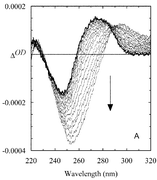Comparison between the interactions of adenovirus-derived peptides with plasmid DNA and their role in gene delivery mediated by liposome–peptide–DNA virus-like nanoparticles
Abstract
Previously we have described the development and applications of an important new platform system for gene delivery known as liposome–mu–DNA (LMD), prepared from cationic liposomes (L), plasmid DNA (D) and the μ (M) peptide derived from the adenovirus core. In an attempt to improve upon mu, an alternative peptide (pepV) derived from the adenovirus peptide/protein–DNA core complex was identified, synthesised and studied alongside mu using a number of biophysical techniques including gel retardation, ethidium bromide exclusion, CD binding titration, DNA melting, and plasmid protection assays. PepV binds to pDNA less efficiently than mu but is able to charge neutralise and condense pDNA into negatively charged pepVD particles comparable in dimension to MD particles. The results of CD studies and plasmid protection assays suggest that peptide–DNA interactions are likely to cause pDNA condensation by a combination of charge neutralisation, base pair tilting, double helix destabilisation and the induction of pDNA superfolding. Data suggest that pepVD particles may be formulated with cationic liposomes to give defined LpepVD particles that appear to transfect HeLa cells with marginally more efficiency than LMD particles suggesting that pepV may have some effect on the pDNA transcription process. Although pepV harbours a nuclear–nucleolar localisation sequence (NLS), transfection data show that this capacity is not being appropriately harnessed by the current LpepVD formulation. Further improvements may be required in terms of optimising LpepVD formulations – for instance, to ensure the integrity of the peptide–DNA complexes following cell entry – in order to fully exploit the full NLS capacity of the peptide, thereby facilitating the transfection of slowly dividing or quiescent cells.


 Please wait while we load your content...
Please wait while we load your content...